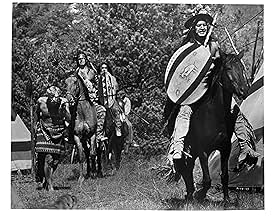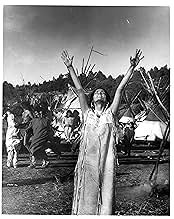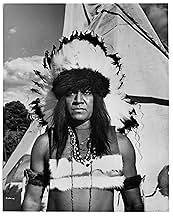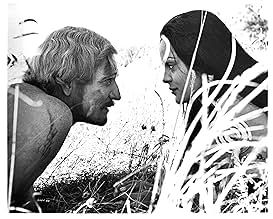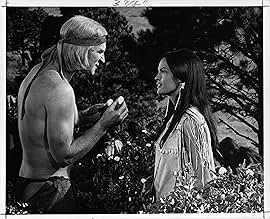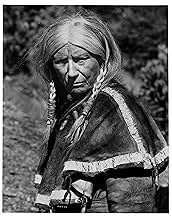IMDb RATING
6.8/10
9.8K
YOUR RATING
In 1825, an English aristocrat is captured by Native Americans. He lives with them and begins to understand their way of life. Eventually, he is accepted as part of the tribe and aspires to ... Read allIn 1825, an English aristocrat is captured by Native Americans. He lives with them and begins to understand their way of life. Eventually, he is accepted as part of the tribe and aspires to become their leader.In 1825, an English aristocrat is captured by Native Americans. He lives with them and begins to understand their way of life. Eventually, he is accepted as part of the tribe and aspires to become their leader.
- Director
- Writers
- Stars
- Awards
- 1 win & 2 nominations total
Judith Anderson
- Buffalo Cow Head
- (as Dame Judith Anderson)
Lina Marín
- Thorn Rose
- (as Lina Marin)
- Director
- Writers
- All cast & crew
- Production, box office & more at IMDbPro
Featured reviews
This is the story of Lord John Morgan, an honest earthy person who is captured by the Sioux in 1825. Abused and treated as an animal he comes to adapt to his life in order to survive. Enduring torture and oppression he must earn their respect in order to be accepted as part of their tribe.
The white man as part of a Sioux tribe story was given a major shot in the arm with Kevin Costner's Oscar bagger, Dances With Wolves in 1990. This picture came out some twenty years before Costner's stylish picture but the two films couldn't be further apart in terms of story telling. Here in Elliot Silverstein's picture, the scenery and scope is certainly lush, but the niceties stop there for this is a harsh, at times painful, story with realism dripping from each frame. Silverstein wanted to get as close as he could to the facts of the Sioux way of life, even bringing in a Sioux historian to oversee the production.
The Sioux are painted on both sides of the canvas, on one side we are shown them to be violent, even sadistic, but Silverstein also portrays them as an intelligent race driven on by intense loyalty to their ways and culture. Richard Harris plays our main protagonist and has a clear license to act with immense verve and vigour, it's a memorable turn that lingers long after the credits roll. Hurting the film is a twee romance between Morgan and the Chiefs daughter (Judith Anderson) and Jean Gascon's fluctuating accents start to grate entering the film's last quarter. But really the plus points far outweigh the little irritants in the piece. The editing from Philip W. Anderson & Michael Kahn is like a whirling paean to hallucinations, and some scenes are from the top draw, most notably the Vow To The Sun ritual that literally is painful to watch. A Man Called Horse may well be of its time, but it's certainly a very interesting and highly intelligent film. 7/10
The white man as part of a Sioux tribe story was given a major shot in the arm with Kevin Costner's Oscar bagger, Dances With Wolves in 1990. This picture came out some twenty years before Costner's stylish picture but the two films couldn't be further apart in terms of story telling. Here in Elliot Silverstein's picture, the scenery and scope is certainly lush, but the niceties stop there for this is a harsh, at times painful, story with realism dripping from each frame. Silverstein wanted to get as close as he could to the facts of the Sioux way of life, even bringing in a Sioux historian to oversee the production.
The Sioux are painted on both sides of the canvas, on one side we are shown them to be violent, even sadistic, but Silverstein also portrays them as an intelligent race driven on by intense loyalty to their ways and culture. Richard Harris plays our main protagonist and has a clear license to act with immense verve and vigour, it's a memorable turn that lingers long after the credits roll. Hurting the film is a twee romance between Morgan and the Chiefs daughter (Judith Anderson) and Jean Gascon's fluctuating accents start to grate entering the film's last quarter. But really the plus points far outweigh the little irritants in the piece. The editing from Philip W. Anderson & Michael Kahn is like a whirling paean to hallucinations, and some scenes are from the top draw, most notably the Vow To The Sun ritual that literally is painful to watch. A Man Called Horse may well be of its time, but it's certainly a very interesting and highly intelligent film. 7/10
"A Man Called Horse" is a very unusual film about the west for many reasons. It's NOT set during the usual 'glory days' when most films of the type were set (1866-1880). It had no cowboys. And, it had very little dialog in English.
The film begins with a rich Englishman, John Morgan (Richard Harris), on a hunting expedition in the American West in the 1830s. He and his party are attacked by Sioux warriors and Morgan is taken prisoner by the natives. At first, he's treated like a slave and his life truly sucks. It didn't help that the only one who spoke any English in the tribe was another slave who was French...and the guy was a little nuts! Through the course of the film, however, Morgan learns to respect and even enjoy life with the Sioux and becomes an important member of the tribe. There is naturally much more to it than that but it's best you just see it for yourself.
This movie is almost like an ethnographic portrait of the Sioux and the times instead of a typical western film. The usual sorts of clichés and expectations are mostly missing. Some will hate this--some will no doubt be relieved. All I know is that I enjoyed it and liked the more intimate and native-centered approach of the film. Well made all around...though the sun ceremony is NOT for the squeamish.
The film begins with a rich Englishman, John Morgan (Richard Harris), on a hunting expedition in the American West in the 1830s. He and his party are attacked by Sioux warriors and Morgan is taken prisoner by the natives. At first, he's treated like a slave and his life truly sucks. It didn't help that the only one who spoke any English in the tribe was another slave who was French...and the guy was a little nuts! Through the course of the film, however, Morgan learns to respect and even enjoy life with the Sioux and becomes an important member of the tribe. There is naturally much more to it than that but it's best you just see it for yourself.
This movie is almost like an ethnographic portrait of the Sioux and the times instead of a typical western film. The usual sorts of clichés and expectations are mostly missing. Some will hate this--some will no doubt be relieved. All I know is that I enjoyed it and liked the more intimate and native-centered approach of the film. Well made all around...though the sun ceremony is NOT for the squeamish.
In 1825, the Sioux, leaded by Yellow Hand (Manu Tupou), capture the English nobleman John Morgan (Richard Harris), while hunting in the United States of America. John is brutally treated like an animal by the Indian, and is given to help Buffalo Cow Head (Judith Anderson), the mother of Yellow Hand, as if he were a horse. Without understanding the language and behavior of the Sioux, he is helped by Batise (Jean Gascon), a white man made prisoner and mutilated by the Indians five years ago. Batise translates and explains the Sioux's culture for John, plotting to escape some day back to the civilization with him. After an undefined long time later, John loses his snobbish behavior and is reasonably integrated to the Sioux. One day, he kills two enemies Shoshones, who were spying and stalking the Sioux, and gains the respect of the Sioux and love of the sister of Yellow Hand, Running Deer (Corinna Tsopei). John marries Running Deer and integrates to their culture, and after a tragic attack of the Shoshones to the Sioux tribe, he becomes their leader. "A Man Called Horse" is a spectacular and powerful classic western of the 70's. The first time I saw this movie, I was a teenager and left the theater completely astonished with such a different story in that time and the violence of the scenes. Two days ago, I bought the VHS and yesterday I saw it again, and it is still a very impressive film, with magnificent performances of the cast, highlighting Richard Harris and Judith Anderson. The production is very careful, being mostly spoken in Sioux, and depicting in a realistic way, the life, the behavior, the common laws and the moral practices of the Sioux. I believe that "A Man Called Horse", with the Sioux, "Soldier Blue", with the Cheyenne and "Little Big Man", all of them from 1970, were among the first movies to show the lives of prisoners of the North American Indians in their tribes. The amazing scene of John Morgan suspended by his chest in an Indian ceremony is unforgettable and very impressive. My vote is ten.
Title (Brazil): "Um Homem Chamado Cavalo" ("Spectacular Classic Western")
Title (Brazil): "Um Homem Chamado Cavalo" ("Spectacular Classic Western")
Although this film appeared to be a western for the 1970's, the story was not new. The writer, Dorothy M. Johnson, originally wrote it for the T.V. series Wagon Train (1957-65). Ralph Meeker was cast then in the Richard Harris role, and an excellent job he made of it, in his quiet way. A good story will always stand the test of time, as this proves.
One of the first films to ever deal with the relationship between white men and Native Americans that wasn't slanted towards the white man, A MAN CALLED HORSE was released during the same year as the excellent Arthur Penn film LITTLE BIG MAN and the ultra-violent SOLDIER BLUE, which also dealt with the white man/Indian conflict. Richard Harris gives a great performance as an Englishman who loses his wagon team to, and is captured by, a group of Sioux Indians in the Dakota territory of the mid-1800s. He soon learns their ways of living, which primitive as they might be to us and to him are very traditional. Though the film is rated 'PG', be forewarned that there are scenes of violence and bloodshed (particularly the Sun Vow sequence) that could have gotten this film an 'R' (or a 'PG-13'), so the film is not exactly for kids. Nevertheless, it is worth seeing.
Did you know
- TriviaFor his painful Vow to the Sun initiation ceremony scene, Richard Harris wore a prosthetic chest created by make-up artist John Chambers.
- GoofsWhen the Indian child fires an arrow at the two wandering enemy tribe members, the arrow tip has a black rubber sucker on it.
- Alternate versionsOld German VHS version includes many alternate/more violent takes that are not on the US DVD (whereas the version on the DVD is the same as in the US), especially the ending is almost completely recut. On the other hand the US version includes a few lines which are not in the German version.
- ConnectionsEdited into Commercial Entertainment Product (1992)
Details
- Release date
- Countries of origin
- Languages
- Also known as
- Un hombre llamado Caballo
- Filming locations
- Production companies
- See more company credits at IMDbPro
Box office
- Gross US & Canada
- $1,941,247
- Gross worldwide
- $44,000,000
- Runtime1 hour 54 minutes
- Sound mix
- Aspect ratio
- 2.35 : 1
Contribute to this page
Suggest an edit or add missing content



